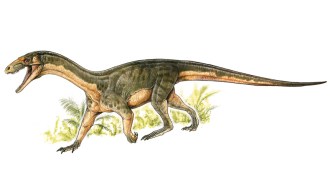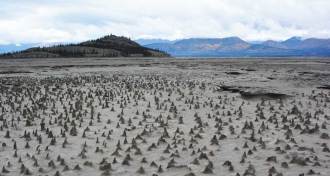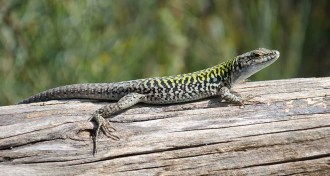All Stories
-
 Planetary Science
Planetary ScienceNitrogen fizz fuels ‘magic island’ on Titan, simulation suggests
Nitrogen bubbles may be the source of the “magic island” on Saturn’s moon Titan.
-
 Planetary Science
Planetary ScienceBubbles may put mysterious fizz in Titan’s polar sea
Nitrogen bubbles may be the source of the “magic island” on Saturn’s moon Titan.
-
 Physics
PhysicsThere’s still a lot we don’t know about the proton
Researchers are puzzling over the proton's radius, spin and whether it decays.
-
 Paleontology
PaleontologyEarly dinosaur relative sported odd mix of bird, crocodile-like traits
Teleocrater rhadinus gives researchers a better picture of what early dinosaur relatives looked like.
-
 Earth
Earth‘River piracy’ on a high glacier lets one waterway rob another
The melting of one of Canada’s largest glaciers has rerouted meltwater from one stream into another in an instance of river piracy.
-
 Animals
AnimalsImprobable ‘black swan’ events can devastate animal populations
Conservation managers should take a note from the world of investments and pay attention to “black swan” events, a new study posits.
-
 Ecosystems
EcosystemsHawk moths convert nectar into antioxidants
Hawk moths use their sugary diet to make antioxidants that protect their muscles.
-
 Physics
PhysicsThe drama of Albert Einstein’s life unfolds in the new series Genius
Science takes a back seat in National Geographic’s series Genius, which focuses more on politics and Albert Einstein’s love life.
-
 Animals
AnimalsSize matters to lizards, but numbers may not
Scientists have sized up the quantitative abilities of lizards and found that reptiles may not be as good with numbers as other vertebrates.
-
 Archaeology
ArchaeologyShock-absorbing spear points kept early North Americans on the hunt
Ancient Americans invented a way to make spear points last on an unfamiliar continent.
By Bruce Bower -
 Particle Physics
Particle PhysicsNew particle probably can’t explain nuclear reactor neutrino mystery
An antineutrino anomaly seems due to problems with scientists’ predictions, not sterile neutrinos.
-
 Oceans
OceansMore than one ocean motion determines tsunami size
The horizontal movement of the seafloor during an earthquake can boost the size of the resulting tsunami, researchers propose.